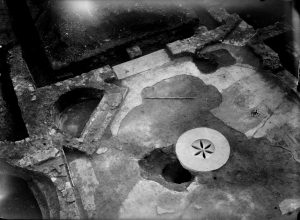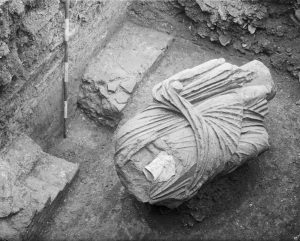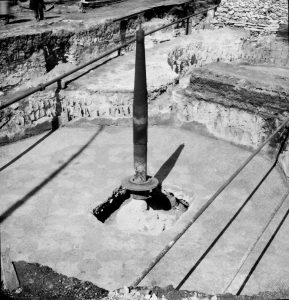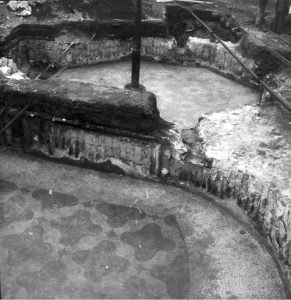The Governor’s Palace complex of approximately 7 hectares lies reburied on Hajógyár Island in Óbuda, awaiting its display to the public. The ruins discovered so far have an exceptional position in the Roman heritage of Budapest not only because of their original function and unique location, but also their internal decorations, wall paintings and mosaic floors. The site’s most important finds and a part of the wall paintings and mosaics are on display in the permanent exhibition of the Aquincum Museum.
The year AD 106 was an important stage in the development of Aquincum: with the division of the province of Pannonia, it became the provincial seat of Pannonia Inferior. Fortunately we know of this fact and the presence of governors not only from written sources and epigraphic evidence; archaeologists also discovered the governor’s palace complex. We know of five construction periods. The construction of the earliest building that was certainly used as the governor’s residence dates to the reign of Hadrian. The biggest reconstruction took place during the early 3rd century (211-222). Further construction work and building use can be traced until the end of the 3rd century, when the palace was likely abandoned deliberately.
The remains of the palace complex lie on what is now known as Hajógyári (Shipyard) Island (which consists of two artificially-connected islands) and more specifically on the former Kis (Small) Island. Only a narrow branch of the Danube separated the island from the Military Town (present-day Óbuda), while the natural vegetation of Nagy (Large) Island blocked the view of the island from Barbaricum on the other side of the river. The governors most likely had their own port by the former Danube branch (present-day Hajógyári bay), facing the main façade of the palace.
Concerning the site we have a more detailed understanding of the main building, measuring roughly 10,000 m sq. The building’s four wings surrounded a central courtyard. The eastern (main) wing – contrary to earlier theories – may also have had only one storey. This wing was used for public and official functions; all rooms there had mosaic floors and the whole wing – including the wide corridors – had underfloor heating. The private baths of the governor were in the northern wing. The southern wing had many functions; it contained staff accommodation, storerooms and a domestic shrine on a smaller inner courtyard. Altars dedicated by the governors in that sanctuary helped archaeologists identify the function of the whole site.
Only a small part of the western wing could be excavated, but given that the western half of the courtyard had an economic function, we can surmise the same for the western wing. There were, among others, large ovens on this half of the courtyard. While the eastern side of the courtyard was paved and decorated there is no sign of that on the western half. There was a sanctuary on the eastern half of the courtyard – presumably for the imperial cult – as well as a smaller aedicula (shrine) of unknown function. The eastern half of the courtyard, too, therefore appears to have had in part a communal, public function.






